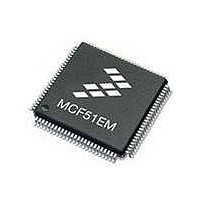MCF51EM256CLL Freescale Semiconductor, MCF51EM256CLL Datasheet - Page 160

MCF51EM256CLL
Manufacturer Part Number
MCF51EM256CLL
Description
IC MCU 32BIT 256KB FLASH 100LQFP
Manufacturer
Freescale Semiconductor
Series
MCF51EMr
Datasheets
1.MCF51EM128CLL.pdf
(2 pages)
2.MCF51EM128CLL.pdf
(54 pages)
3.MCF51EM128CLL.pdf
(636 pages)
Specifications of MCF51EM256CLL
Core Processor
Coldfire V1
Core Size
32-Bit
Speed
50MHz
Connectivity
I²C, SCI, SPI
Peripherals
LCD, LVD, PWM, WDT
Number Of I /o
63
Program Memory Size
256KB (256K x 8)
Program Memory Type
FLASH
Ram Size
16K x 8
Voltage - Supply (vcc/vdd)
1.8 V ~ 3.6 V
Data Converters
A/D 16x12b
Oscillator Type
External
Operating Temperature
-40°C ~ 85°C
Package / Case
100-LQFP
Processor Series
MCF51EM
Core
ColdFire V1
Data Bus Width
32 bit
Data Ram Size
16 KB
Interface Type
RS-232, LIN
Maximum Clock Frequency
50 MHz
Number Of Timers
3
Operating Supply Voltage
1.8 V to 3.6 V
Maximum Operating Temperature
+ 85 C
Mounting Style
SMD/SMT
3rd Party Development Tools
JLINK-CF-BDM26, EWCF
Development Tools By Supplier
DEMOEM
Minimum Operating Temperature
- 40 C
Lead Free Status / RoHS Status
Lead free / RoHS Compliant
Eeprom Size
-
Lead Free Status / Rohs Status
Lead free / RoHS Compliant
Available stocks
Company
Part Number
Manufacturer
Quantity
Price
Company:
Part Number:
MCF51EM256CLL
Manufacturer:
FREESCALE
Quantity:
110
Company:
Part Number:
MCF51EM256CLL
Manufacturer:
Freescale Semiconductor
Quantity:
10 000
- Current page: 160 of 636
- Download datasheet (11Mb)
Modes of Operation
low power run mode cannot be entered again until after a system reset. Note that BKGD/MS is multiplexed
with PTC2. The pin must be configured as BKGD/MS for this operation to occur.
6.7
6.7.1
Wait mode is entered by executing a STOP instruction after configuring the device as per
execution of the STOP instruction, the CPU enters a low-power state in which it is not clocked.
The V1 ColdFire core does not differentiate between stop and wait modes. Both are stop from the core’s
perspective. The difference between the two is at the device level. In stop mode, most peripheral clocks
are shut down. In wait mode, they continue to run.
XCSR[ENBDM] must be set prior to entering wait mode if the device is required to respond to BDM
commands once in wait.
When an interrupt request occurs, the CPU exits wait mode and resumes with exception processing,
beginning with the stacking operations leading to the interrupt service routine.
6.7.2
Low-power wait mode is entered by executing a STOP instruction while the MCU is in low-power run
mode and configured per
its standby state as in the low-power run mode. In this state, the power consumption is reduced to a
minimum that allows most modules to maintain funtionality. Power consumption is reduced the most by
disabling the clocks to all unused peripherals by clearing the corresponding bits in the SCGCx registers.
Low-power run mode restrictions also apply to low-power wait mode.
If SPMSC2[LPWUI] is set when the STOP instruction is executed, the voltage regulator returns to full
regulation when wait mode is exited. The ICS FLLs can be set for full speed immediately in the interrupt
service routine.
If SPMSC2[LPWUI] is cleared when the STOP instruction is executed, the device returns to low-power
run mode.
Any reset exits low-power wait mode, clears SPMSC2[LPR], and returns the device to normal run mode.
6.7.2.1
If a device is in low-power wait mode, a falling edge on the BKGD/MS pin exits low-power run/wait
mode, clears the LPRS bit in SPMSC2, and returns the device to normal run mode. The LPR bit remains
set and low power run mode cannot be entered again until after a system reset. Again, note that BKGD/MS
is multiplexed with PTC2. The pin must be configured as BKGD/MS for this operation to occur.
6-8
Wait Modes
Wait Mode
Low-Power Wait Mode (LPwait)
BDM in Low-Power Wait Mode
MCF51EM256 Series ColdFire Integrated Microcontroller Reference Manual, Rev. 8
Table
6-1. In the low-power wait mode, the on-chip voltage regulator remains in
Freescale Semiconductor
Table
6-1. Upon
Related parts for MCF51EM256CLL
Image
Part Number
Description
Manufacturer
Datasheet
Request
R

Part Number:
Description:
BOARD DEMO HARDWARE ONLY
Manufacturer:
Freescale Semiconductor
Datasheet:

Part Number:
Description:
IC MCU 32BIT 128KB FLASH 100LQFP
Manufacturer:
Freescale Semiconductor
Datasheet:

Part Number:
Description:
IC MCU 32BIT 128KB FLASH 80LQFP
Manufacturer:
Freescale Semiconductor
Datasheet:

Part Number:
Description:
IC MCU 32BIT 256KB FLASH 80LQFP
Manufacturer:
Freescale Semiconductor
Datasheet:
Part Number:
Description:
Manufacturer:
Freescale Semiconductor, Inc
Datasheet:
Part Number:
Description:
Manufacturer:
Freescale Semiconductor, Inc
Datasheet:
Part Number:
Description:
Manufacturer:
Freescale Semiconductor, Inc
Datasheet:
Part Number:
Description:
Manufacturer:
Freescale Semiconductor, Inc
Datasheet:
Part Number:
Description:
Manufacturer:
Freescale Semiconductor, Inc
Datasheet:
Part Number:
Description:
Manufacturer:
Freescale Semiconductor, Inc
Datasheet:
Part Number:
Description:
Manufacturer:
Freescale Semiconductor, Inc
Datasheet:
Part Number:
Description:
Manufacturer:
Freescale Semiconductor, Inc
Datasheet:
Part Number:
Description:
Manufacturer:
Freescale Semiconductor, Inc
Datasheet:
Part Number:
Description:
Manufacturer:
Freescale Semiconductor, Inc
Datasheet:











